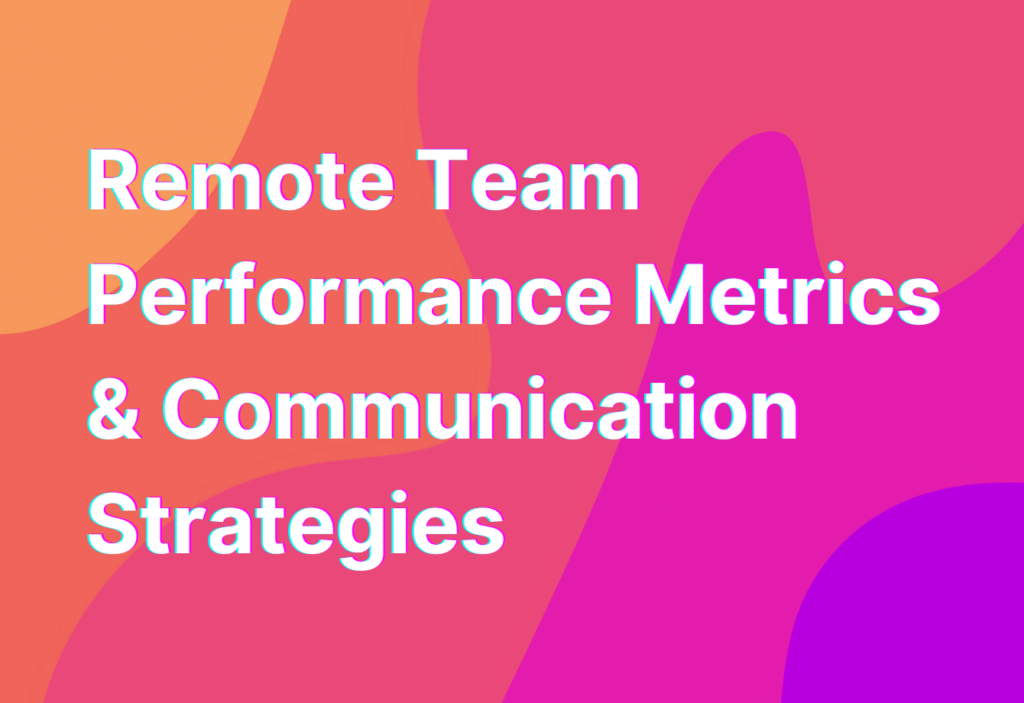Remote Team Performance Metrics & Communication Strategies
Hey there, remote work enthusiasts! It’s Ashley here, your friendly remote work advocate with 10 years of experience in the tech industry. Today, I want to dive into the world of remote team performance metrics and communication strategies. As we all know, working remotely comes with its own set of challenges, but with the right metrics and communication strategies in place, we can overcome them and thrive as a team. So, let’s get started!
The Importance of Performance Metrics
Performance metrics are like the compass that guides us in the remote work world. They help us measure our progress, identify areas for improvement, and ensure that we’re on track to meet our goals. Without performance metrics, it’s like sailing in the dark without a map – you might end up lost or going in circles.
When it comes to remote teams, performance metrics play an even more crucial role. Since we’re not physically present in the same office, it can be challenging to gauge how well we’re performing as a team. That’s where performance metrics come in handy. They provide us with tangible data that allows us to assess our productivity, efficiency, and overall performance.
So, what are some performance metrics that remote teams should consider? Let’s take a look:
- Productivity: This metric measures how efficiently team members are completing their tasks. It can be measured by the number of tasks completed, the time taken to complete them, or the output produced.
- Quality: Quality is key, no matter where you work. This metric assesses the accuracy, reliability, and overall quality of the work produced by remote team members.
- Communication: Effective communication is the backbone of remote teams. This metric evaluates how well team members are communicating with each other, whether it’s through emails, video calls, or project management tools.
- Collaboration: Collaboration is essential for remote teams to succeed. This metric measures how well team members are working together, sharing ideas, and collaborating on projects.
- Engagement: Remote work can sometimes feel isolating, so it’s important to measure team members’ engagement and satisfaction. This metric can be assessed through surveys, feedback sessions, or other engagement tools.
Now that we know some of the key performance metrics for remote teams, let’s explore some communication strategies that can help us improve these metrics and foster a more productive and connected remote work environment.
Communication Strategies for Remote Teams
Communication is the glue that holds remote teams together. Without effective communication, remote teams can quickly become disconnected and disengaged. But fear not, my fellow remote workers, because I’ve got some communication strategies up my sleeve that can help us overcome these challenges:
- Regular Check-Ins: Schedule regular check-ins with your team members to stay connected and aligned. These can be daily stand-up meetings, weekly progress updates, or monthly team syncs. The key is to have a consistent cadence that works for everyone.
- Use the Right Tools: Invest in reliable communication and collaboration tools that facilitate seamless communication. Whether it’s project management software like Trello or communication platforms like Slack, find the tools that work best for your team’s needs.
- Establish Clear Communication Channels: Define clear communication channels for different types of communication. For example, use email for formal communication, instant messaging for quick questions, and video calls for more in-depth discussions.
- Encourage Active Listening: Remote communication can sometimes be misinterpreted, so it’s important to encourage active listening. Encourage team members to ask clarifying questions, repeat back information to ensure understanding, and practice empathy in their communication.
- Promote Social Interaction: Remote work doesn’t mean we can’t have a little fun! Encourage social interaction among team members through virtual team-building activities, casual video chats, or even a dedicated Slack channel for non-work-related conversations.
By implementing these communication strategies, we can enhance our remote team’s performance metrics and create a more connected and engaged work environment. Remember, communication is a two-way street, so it’s important to foster open and transparent communication channels where everyone feels heard and valued.
Wrapping Up
And there you have it, folks! We’ve explored the world of remote team performance metrics and communication strategies. By measuring our performance using metrics like productivity, quality, communication, collaboration, and engagement, and implementing effective communication strategies, we can overcome the challenges of remote work and thrive as a team.
If you want to dive deeper into the topic of communication strategies for remote teams, be sure to check out our article on Quality assurance (QA) communication strategies for remote teams. It’s packed with even more tips and tricks to help you improve your remote team’s communication game.
Until next time, happy remote working!


